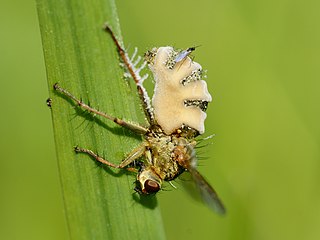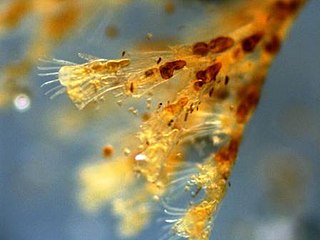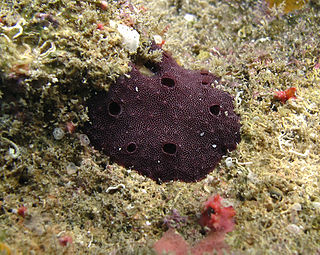
The Scorpaeniformes are a diverse order of ray-finned fish, including the lionfish, but have also been called the Scleroparei. It is one of the five largest orders of bony fishes by number of species, with over 1,320.

Acinonyx is a genus within the cat family. The only living species of the genus, the cheetah, lives in open grasslands of Africa and Asia.

The long-tailed vole, in some areas known as the San Bernardino long-tailed vole, is a small vole found in western North America. They have short ears and a long tail. Their fur is gray brown with light gray underparts. They are around 18 cm (7.1 in) long with an 8 cm (3.1 in) tail and weigh about 50 g (1.8 oz).

Gelechioidea is the superfamily of moths that contains the case-bearers, twirler moths, and relatives, also simply called curved-horn moths or gelechioid moths. It is a large and poorly understood '"micromoth" superfamily, constituting one of the basal lineages of the Ditrysia.

Hicksbeachia is a genus of two species of trees in the family Proteaceae. They are native to rainforests of northern New South Wales and southeastern Queensland. They are commonly known as red bopple nut or beef nut due to the bright red colour of their fruits.

Cephalanthera, abbreviated Ceph in horticultural trade, is a genus of mostly terrestrial orchids. Members of this genus have rhizomes rather than tubers. About 15 species are currently recognized, most of them native to Europe and Asia. The only species found in the wild in North America is Cephalanthera austiniae, the phantom orchid or snow orchid. Ecologically, this species is partially myco-heterotrophic. Some of the Eurasian species hybridise.
Diclonius is a genus of dinosaur from the Late Cretaceous. It was a hadrosaur based solely on teeth. Its fossils were found in the Judith River Formation of Montana, northern US. The name is in reference to the method of tooth replacement, in which newly erupting replacement teeth could be in functional use at the same time as older, more worn teeth. Thus, the number of "sprouting" teeth was doubled in comparison to Monoclonius, which used only one set of teeth at a time and which Cope named in the same paper.

Musgravea is a genus of rainforest tree from north-eastern Queensland.

Euploea is a genus of milkweed butterflies. The species are generally dark in coloration, often quite blackish, for which reason they are commonly called crows. As usual for their subfamily, they are poisonous due to feeding on milkweeds and other toxic plants as caterpillars. The latter are aposematically colored to warn off predators from eating them, and the adult butterflies are often mimicked by unrelated species which are not or less poisonous.

The Entomophthorales are an order of fungi that were previously classified in the class Zygomycetes. A new subdivision, Entomophthoromycotina, has recently been circumscribed for them.

Campanulariidae is a family of animals in the phylum Cnidaria, or stinging-celled animals. Campanulariidae is composed entirely of hydroids, a Greek term meaning "water animals" applied to the plant-like polyp colonies of the class Hydrozoa. All species of the Campanulariidae are aquatic in habitat, primarily inhabiting coastal regions and tidal pools.

Duriavenator is a genus of theropod dinosaur described in 2008 by Roger Benson; its finds were excavated in England. The only named species in the genus is Duriavenator hesperis, formerly known as Megalosaurus hesperis. Duriavenator lived during the Bajocian stage, between 169.1 and 168.7 million years ago, making it one of the oldest-known Tetanurae. The genus name combines the Latin name of Dorset, Duria, with Latin for "hunter", venator. This genus has also gone under the unofficial name "Walkersaurus", which is a nomen nudum. It has been estimated to be 7 meters in length.
Echinostelium is a genus of slime mould, and the only genus in the family Echinosteliaceae, or Echinosteliidae. It was discovered by Heinrich Anton de Bary in 1855, apparently near Frankfurt am Main. Some species of Echinostelium have a sexual life cycle; others have been shown to be asexual. The plasmodium can divide vegetatively, in a process called plasmotomy, to distinguish it from true cell division.

Vermicularia is a genus of sea snails, marine gastropod mollusks in the family Turritellidae.

Darwinellidae is a family of sponges in the order Dendroceratida.
Henry Carsten Kellers was an American United States Navy Lieutenant Commander who served on numerous scientific expeditions on behalf of the Smithsonian Institution. During his expeditionary career, he collected biological specimens for the Smithsonian, bringing back over 10,000 specimens, living and deceased, many which were held by the National Zoo in Washington, D.C..

Entomophthoromycota is a fungus division. In 2007, it was placed at the taxonomic rank of subphylum in the most recent revision of the entire fungus kingdom. In 2012, it was raised to the rank of phylum as "Entomophthoromycota" in a scientific paper by Richard A. Humber 2012. Divided into three classes and six families, it contains over 250 species that are mostly arthropod pathogens or soil- and litter-borne saprobes.

Aerodactylus is a pterosaur genus containing a single species, Aerodactylus scolopaciceps, previously regarded as a species of Pterodactylus.

Notatesseraeraptor is a genus of carnivorous theropod dinosaur that lived during the Late Triassic of what is now Switzerland. It was found in the Gruhalde Member of the Klettgau Formation. It was an early member of Neotheropoda with affinities to Dilophosaurus and Averostra. The new genus and species Notatesseraeraptor frickensis was named by Marion Zahner and colleagues in 2019.
Gastroblastea is a genus of cnidarians belonging to the family Campanulariidae.















